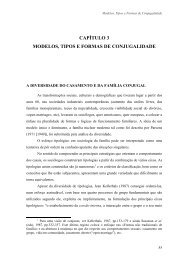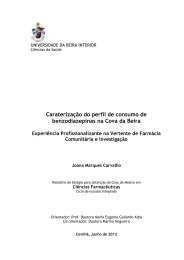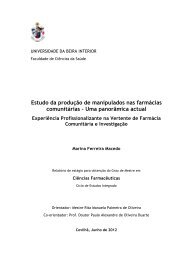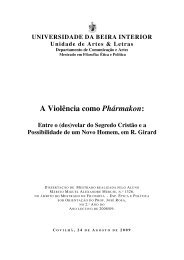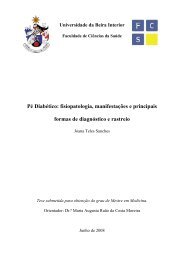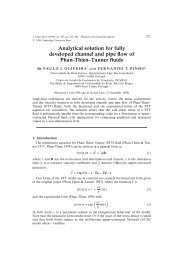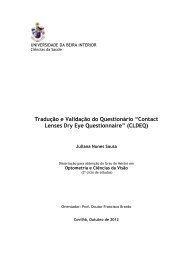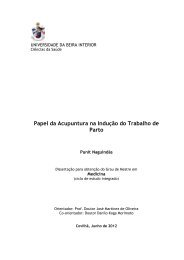Tese_Tânia Vieira.pdf - Ubi Thesis
Tese_Tânia Vieira.pdf - Ubi Thesis
Tese_Tânia Vieira.pdf - Ubi Thesis
Create successful ePaper yourself
Turn your PDF publications into a flip-book with our unique Google optimized e-Paper software.
Chapter I - Introduction<br />
ROS production that<br />
damage cellular and<br />
viral components<br />
Silver ions may denature<br />
ribosomes, thereby<br />
inhibiting protein synthesis<br />
and causing degradation of<br />
the cell membrane.<br />
Silver ions cause<br />
destruction of the<br />
peptidoglycan<br />
bacterial cell wall<br />
and lysis of the cell<br />
membrane.<br />
70S ribosome<br />
Silver ions bind to DNA<br />
bases. This causes DNA to<br />
condense and lose its<br />
ability to replicate,<br />
thereby preventing<br />
bacterial reproduction via<br />
binary fission.<br />
Bacterial cell wall<br />
Plasmid DNA<br />
Silver ions<br />
Figure 2 – Different mechanisms of action of AgNPs against bacteria. In general, these mechanisms include:<br />
photocatalytic production of ROS that damage cellular and viral components, compromising the bacterial<br />
cell wall/membrane, interruption of energy transduction, and inhibition of enzyme activity and DNA<br />
synthesis. Adapted from (Chaloupka et al. 2010; Huh et al. 2011).<br />
1.3.3. Bacterial silver nanoparticles resistance<br />
The probability of AgNPs induce microorganism resistance is much lower than that of<br />
conventional antibiotics (Xu et al. 2011) or than other antimicrobial materials (Li et al. 2011).<br />
This ability to promote minimal (Ip et al. 2006) or no resistance in microorganisms (Prucek et al.<br />
2011) allows to postulate their use for replace some of the antibiotics presently in use (Sheikh et<br />
al. 2010). This ability is due the fact that the metal attacks a broad range of targets in the<br />
organisms, which means that they would have to develop a host of mutations simultaneously to<br />
protect themselves from the AgNPs (Pal et al. 2007). Furthermore, the presence of this multiple<br />
bactericidal mechanisms that act in synergy against bacteria, makes more difficult the<br />
acquisition of resistance by bacteria to AgNPs (Chaloupka et al. 2010).<br />
In fact, resistance to silver is rare, but not unknown (Atiyeh et al. 2007). In the literature,<br />
there are two forms of resistance described: cells can bind to silver and form an intracellular<br />
complex, or they can be excreted from microorganisms, by using cellular efflux systems (Atiyeh<br />
et al. 2007). Li and collaborators showed that resistance was induced using low concentrations of<br />
silver (Li et al. 1997). Bactericidal levels of silver do not produce resistance, however, minimum<br />
inhibitory concentration (MIC) (2–4 mg Ag + /L) and sub-MIC levels can allow the development of<br />
resistance by bacteria (Atiyeh et al. 2007). This occurs due to halide ions that act as<br />
precipitating agents, for example, the chloride remove Ag + by precipitating in the form of silver<br />
13




